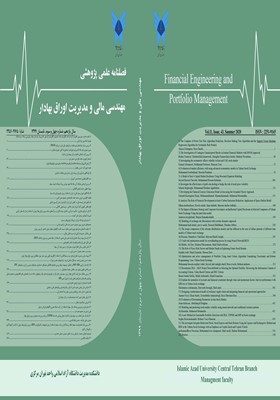ارائه مدل ترکیبی DEA-MLP در تشکیل سبدبهینه سهام: بررسی محتوای اطلاعاتی معیارهای حسابداری، معیارهای مبتنی بر ارزش و معیارهای BSC
الموضوعات : Financial engineering
حسن فتاحی نافچی
1
,
مهدی عربصالحی
2
,
مجید اسماعیلیان
3
![]()
1 - گروه حسابداری، دانشکده علوم اداری و اقتصاد، دانشگاه اصفهان، اصفهان، ایران
2 - گروه حسابداری، دانشکده علوم اداری و اقتصاد، دانشگاه اصفهان، اصفهان، ایران
3 - گروه مدیریت، دانشکده علوم اداری و اقتصاد، دانشگاه اصفهان، اصفهان، ایران
الکلمات المفتاحية: تحلیل پوششی دادهها, سبد بهینه سهام, الگوریتم حذف دادهای پرت, شبکههای عصبی MLP,
ملخص المقالة :
این هدف میتواند با استفاده از روشها و الگوریتمهای مختلفی صورت پذیرد. هدف پژوهش حاضر تدوین مدل سبد بهینه سهام با استفاده از ترکیب روشهای تحلیل پوششی دادهها، الگوریتم حذف دادهای پرت و شبکههای عصبی MLP است. جامعه آماری پژوهش شرکتهای پذیرفتهشده در بورس اوراق بهادار تهران در بازه زمانی 1386 تا 1396 میباشد. برای تشکیل سبد بهینه سهام از تمام معیارهای موجود دستهبندی شده برای رسیدن به سبد سهام بهینه استفاده گردید. سپس نتایج بهدستآمده در رویکردهای مختلف بر اساس معیار نسبت شارپ با هم مقایسه شد. یافتههای حاصل از پژوهش حاکی از آن است که استفاده از ترکیب تحلیل پوششی دادهها، الگوریتم حذف دادهای پرت، شبکههای عصبی MLP و معیارهای حسابداری در تهیه سبد بهینه سهام منجر به افزایش نسبت شارپ در مقایسه با سایر رویکردها (ریسک و بازده، مبتنی بر ارزش و ارزیابی متوازن) میشود. بهطورکلی بهکارگیری همزمان روشهای ترکیبی بهینهسازی و معیارهای جامع استخراجشده از گزارشهای حسابداری میتواند سبد سهام بهینهتر و مطلوبیت بیشتر را برای سرمایهگذاران به همراه داشته باشد.
Zhang, WG. & Nie, ZK. (2004). On Admissible Efficient Portfolio Selection Problem. Applied Mathematics and Computation, 159 (2), 357-371.
_||_1) Sinaii, Hassan Ali, and Ghastasbi Maharloi, Rasool (2011). Evaluating the efficiency and relative performance of companies with the data coverage analysis approach in order to form a stock portfolio. Journal of Accounting Knowledge, 3(11). 132-105.
10) Kaplan, R. S., & Norton, D. P. (1996). The Strategy-Focused Organization: How Balanced Scorecard Companies Survive in the New Business Environment, Boston, MA: Harvard Business School Press.
11) Kocadagli, Ozan; & Ridvan Keskin (2015). A Novel Portfolio Selection Model Based on Fuzzy Goal Programming with Different Importance and Priorities. Expert Systems with Applications, 42(20), 6898-6912.
12) Lehmann, D. R., Zahay, D., & Peltier, J. W. (2013). Survey analyze customer relationship management using balanced scorecard. Journal of Interactive Marketing, 27(1), 1-16.
13) Ratnasingam, P. (2009). Service quality management applying the balanced scorecard: An exploratory study. International Journal of Commerce and Management, 19(2), 127-136.
14) Song, Irene (2014). New Quantitative Approaches to Asset Selection and Portfolio Construction. Dissertation of Doctor of Philosophy, Columbia University.
15) Vapnik, V., 1998, Statistical Learning Theory. Wiley, New York.
2) Namazi, Mohammad, and Azimibidgholi, Mustafa (1391). Determining the criteria of balanced evaluation and their ranking using the process of hierarchical analysis in the companies accepted in the Tehran Stock Exchange. Financial Accounting Quarterly, 10(35), 1-12.
3) Namazi, Mohammadov and Ghafari, Mohammad Javad. (2014). Investigating the importance and role of managers' ability information and financial ratios as a criterion in choosing the optimal stock portfolio in companies listed on the Tehran Stock Exchange (using data coverage analysis). Financial Accounting Quarterly, 7(26), 1-30.
4) Ben Abdelaziz, F., Aouni, B. & Fayedh, R.E. (2007). Multi-Objective Stochastic Programming for Portfolio Selection. European Journal of Operational Research, 4(177). 1811-1823.
5) Cevikalp, H. (2010). New Clustering Algorithm for the Support Vector Machine Based Hierarchical Classification. Pattern Recognition Letters, 31(18), 1285-1291.
6) Chen, T. Y., & Chen, L. H. (2007). DEA performance evaluation based on BSC indicators incorporated: The case of semiconductor industry. International Journal of Productivity and Performance Management, 56(4), 335-357.
7) Cunha Callado, A. A., & Jack, L. (2015). Balanced scorecard metrics and specific supply chain roles. International Journal of Productivity and Performance Management, 64(2), 288-300.
8) Halkos, G. E., & D. S., Salamouris (2004). Efficiency Measurement of the Greek Commercial Banks with the Use of Financial Ratios: A Data Envelopment Analysis Approach, Management Accounting Research, 15(2), 201-224.
9) Horngren, C. T., Datar, S. D., & Rajan, M. V. (2012). Cost accounting: A managerial emphasis (14th ed). New Jersey, USA: Pearson Prentice Hall.
Zhang, WG. & Nie, ZK. (2004). On Admissible Efficient Portfolio Selection Problem. Applied Mathematics and Computation, 159 (2), 357-371.


